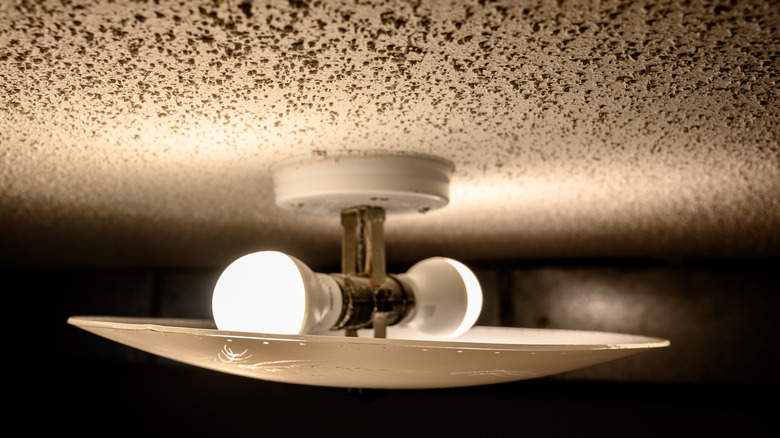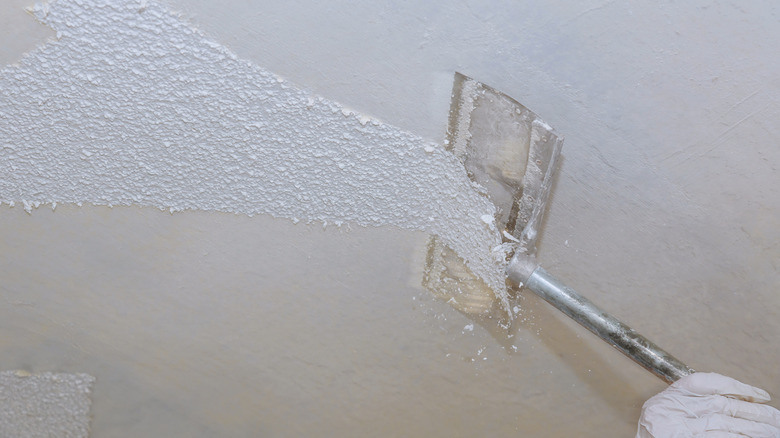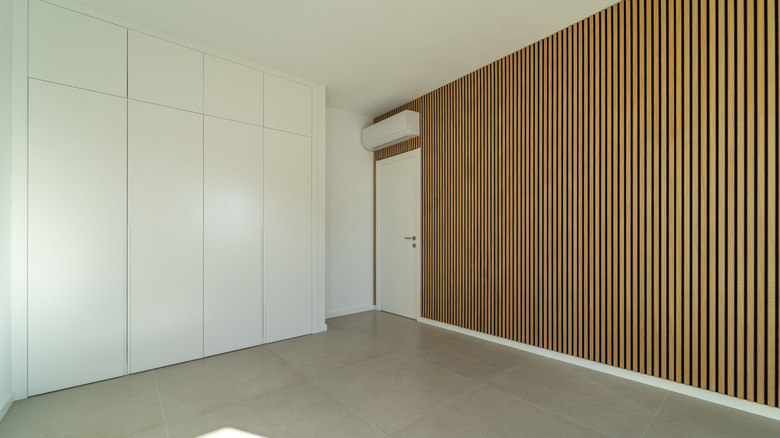Do Popcorn Ceilings Actually Dampen Sounds? Here's What The Expert Says
We may receive a commission on purchases made from links.
Popcorn ceilings may look outdated in homes today, but when they were first popularized in America during the 1950s, builders found the bumpy texture surprisingly practical. Originally marketed as a quick way to finish ceilings during the postwar housing boom, the spray-on coating helped contractors easily hide imperfections and save on labor costs. Early formulas often included vermiculite (that white stuff you see in your potting soil) and asbestos (that toxic old-school building material that's infamous for causing lung disease.) Modern popcorn ceiling mixtures have evolved over time, although the resulting cottage cheese-like bumps are still also rumored to soundproof rooms, thanks to their irregularity. But, according to Steve Snider, Acoustical Consultant at Acoustical Solutions, any noise dampening is minimal and there are better options worth considering, depending on how you want to control sound in your home.
"To some extent popcorn ceilings can dampen sound, however, the amount of dampening (both sound transfer and absorption) is nominal and likely would not be noticeable to the human ear," Snider told House Digest during an exclusive interview. The acoustical expert explained that today's popcorn ceilings are made from a variety of mixed particles like calcium carbonate, polystyrene, limestone, and Styrofoam, which are sprayed onto ceilings before being painted. "Any addition of material to a wall or ceiling assembly will have an impact on an assembly's ability to dampen sound," he said. However, neither historic nor cutting-edge popcorn ceiling textures offer enough mass or absorption power to truly block sound or reverberation. For today's homeowners, there are far better and more stylish options for tackling acoustics.
Popcorn ceiling textures don't offer enough sound dampening to make the investment worthwhile
If you can't wait to remove your popcorn ceiling, you've probably noticed that the texture collects plenty of dust and debris over time. In theory, that's what should happen to sound waves, as well. In reality, Steve Snider says that's just a common myth. "Popcorn ceilings are commonly referred to as acoustic because absorptive materials and an uneven finish surface are the key components of this style of drywall/plaster finishing," the acoustical expert explained during his exclusive interview with House Digest. "While adding these elements are considered "acoustic", the amount of material used in a popcorn ceiling is nominal and would not be enough to justify this as a significant acoustic element," he explained. In other words, it's basically an industry-misnomer that promises sound dampening, that popcorn ceiling textures just can't deliver.
There are several ceiling textures that reduce noise in your home without looking outdated. From the stomp and knockdown textures commonly found in new builder grade homes, to more elaborate fans, swirls, and even stenciled designs that look embossed, any texture beats a totally smooth surface that will continually bounce noise around. But according to Snider, you should probably leave popcorn ceiling textures in the past. "I would not recommend a popcorn ceiling for acoustic purposes. From [an] acoustic perspective, there is not a significant impact on the acoustics for the investment," added our expert. And, if you change your mind in the future and decide to remove your popcorn ceiling, you're looking at a significant additional expense, as the removal process averages around $2,000.
Alternatives to popcorn ceilings for soundproofing your home
So what should you do if your home is too loud, either because the kids are bouncing (sound) off the walls or your entertainment center shakes the whole place when subtitles aren't cutting it? There are a lot of ways to soundproof a room. According to Steve Snider, your first step is to define the kind of dampening that's right for your unique space and situation. "The specific goals of a project need to be considered," the acoustical expert told House Digest during his exclusive interview. "If you are dampening sound transmission, you would simply want to add mass/density to a surface," he explained, adding that Mass Loaded Vinyl, air gaps, or more gypsum board are all good choices that can cut down on sound in adjoining rooms without taking up much space. Snider also recommended using products like Green Glue Noiseproofing Compound, which you can find online or at your local big box store.
"If you are dampening reverberation, or reflections within a space, then the addition of absorptive material within the space is needed," Snider said, although he cautioned that this won't necessarily impact the transmission of sound itself. The most common approaches are adding carpet, upholstered furniture, or other materials that are designed to reduce reverb, like sound dampening panels. "Adding texture can help more evenly distribute sound, as any uneven surface will act as a sound diffuser and help to eliminate flutter echo and improve clarity," our expert added.


